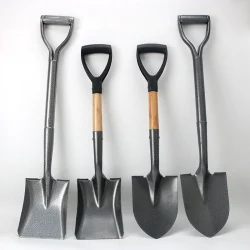Key features and considerations when choosing a garden shovel
2024-04-25
A garden shovel is an essential tool for gardening and landscaping tasks, designed for digging, lifting, and moving soil, compost, mulch, and other materials. Here are some key features and considerations when choosing a garden shovel:
1. Blade Design: The blade of a garden shovel comes in various shapes and sizes, each suited to different gardening tasks:
- Round Point Shovel: This versatile shovel has a rounded blade that is ideal for digging and lifting soil, planting trees and shrubs, and digging trenches.
- Square Point Shovel: A square-point shovel has a flat, squared-off blade that is suitable for edging, digging trenches, and moving loose materials like gravel and sand.
- Trenching Shovel: Trenching shovels have a narrow, pointed blade that is designed for digging narrow trenches and ditches for irrigation or drainage purposes.
- Scoop Shovel: Scoop shovels have a wide, deep blade with high sides, making them ideal for moving loose materials such as mulch, compost, or snow.
2. Blade Material: The blade of a garden shovel is typically made from steel or aluminum. Steel blades are durable and strong, suitable for heavy-duty digging and cutting through roots and tough soil. Aluminum blades are lightweight and corrosion-resistant, making them easier to handle and maneuver.
3. Handle Material: Garden shovel handles are commonly made from wood, fiberglass, or steel. Wood handles provide a traditional look and feel, but they may splinter or break over time. Fiberglass handles are lightweight, durable, and resistant to weather and chemicals. Steel handles offer strength and durability but may be heavier to use.
4. Handle Length: Consider the length of the shovel handle, as it affects leverage and comfort during use. Longer handles provide more leverage for digging and lifting heavy loads but may be more cumbersome to maneuver in tight spaces. Shorter handles offer better control and are suitable for smaller individuals or confined spaces.
5. Grip: Look for a garden shovel with a comfortable and ergonomic grip that reduces hand fatigue and strain during prolonged use. Rubber or padded grips provide cushioning and improve grip, especially when working in wet or muddy conditions.
6. Weight: Consider the weight of the garden shovel, as it affects ease of use and maneuverability. Lightweight shovels are easier to handle and carry for extended periods but may be less durable than heavier models.
7. Additional Features: Some garden shovels come with additional features for added functionality and convenience, such as:
- D-shaped Handle: D-shaped handles provide a comfortable grip and allow for better control and leverage when digging.
- Foot Step: Some shovels have a foot step or tread on the blade, allowing you to apply more pressure with your foot when digging into hard or compacted soil.
- Powder-Coated Finish: A powder-coated finish on the blade helps prevent rust and corrosion, extending the lifespan of the shovel.
By considering these features and factors, you can choose a garden shovel that is well-suited to your gardening needs and preferences, making your gardening tasks more efficient and enjoyable.



